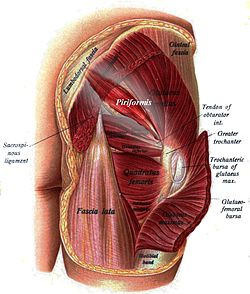
Back عضلة كمثرية Arabic Múscul piramidal de la pelvis Catalan Musculus piriformis German Músculo piriforme Spanish ماهیچه گلابیشکل Persian Päärynänmuotoinen lihas Finnish Muscle piriforme French השריר האגסי HE Kruškoliki mišić Croatian Muscolo piriforme Italian
| Piriformis muscle | |
|---|---|
 Buttocks seen from behind (the piriformis and the rest of the lateral rotator group are visible) | |
 Muscles of the gluteal and posterior femoral regions seen from the front | |
| Details | |
| Origin | Sacrum |
| Insertion | Greater trochanter |
| Artery | Inferior gluteal, lateral sacral and superior gluteal artery, |
| Nerve | Nerve to the piriformis (L5, S1, and S2) |
| Actions | External rotator of the thigh |
| Identifiers | |
| Latin | musculus piriformis |
| TA98 | A04.7.02.011 |
| TA2 | 2604 |
| FMA | 19082 |
| Anatomical terms of muscle | |
The piriformis muscle (from Latin piriformis 'pear-shaped') is a flat, pyramidally-shaped muscle in the gluteal region of the lower limbs. It is one of the six muscles in the lateral rotator group.
The piriformis muscle has its origin upon the front surface of the sacrum, and inserts onto the greater trochanter of the femur. Depending upon the given position of the leg, it acts either as external (lateral) rotator of the thigh or as abductor of the thigh. It is innervated by the piriformis nerve.